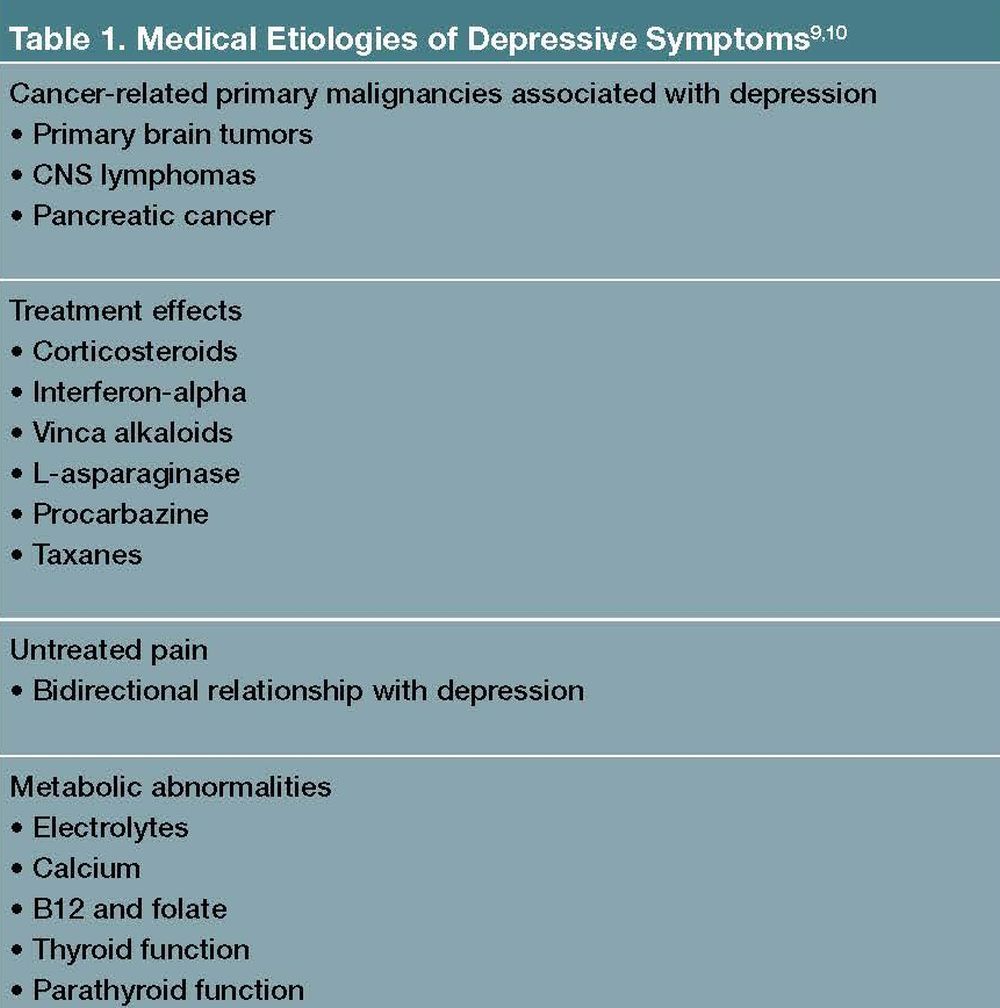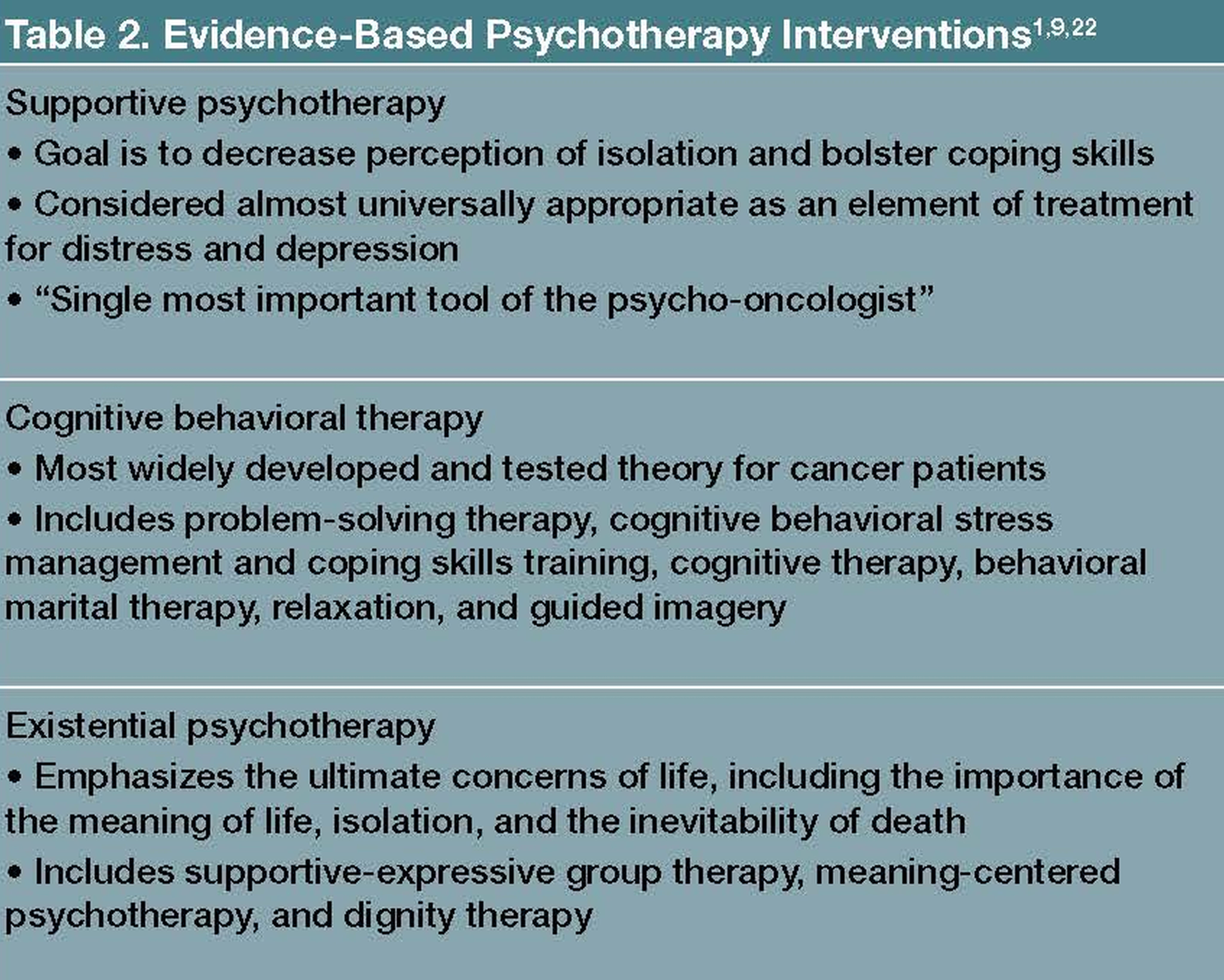Distress extends along a continuum ranging from common feelings of vulnerability, sadness, and fear to problems that can become disabling, such as depression, anxiety, panic, social isolation, and existential and spiritual crisis.
Article
Reducing Distress and Depression
Distress and depression are associated with adverse outcomes in patients with cancer, including reduced quality of life, longer rehabilitation time, poor adherence to treatment, and worse survival.
Andreaobzerova/AdobeStock

SPECIAL REPORT: PSYCHO-ONCOLOGY
A diagnosis of cancer is life changing. Patients with cancer not only experience the physical consequences of the disease and treatment, but may also experience significant emotional distress and impairment in social functioning. Distress is defined as a “multifactorial, unpleasant emotional experience of a psychological (cognitive, behavioral, emotional), social and/or spiritual nature that may interfere with the ability to cope with cancer, its physical symptoms, and treatment.”1 It extends along a continuum ranging from common feelings of vulnerability, sadness, and fear to problems that can become disabling, such as depression, anxiety, panic, social isolation, and existential and spiritual crisis.
Distress and depression are associated with adverse outcomes including reduced quality of life, longer rehabilitation time, poor adherence to treatment, and worse survival.2 Cancer patients with depression have been shown to have four times the mortality rate compared with cancer patients without depression when adjusting for age, performance status, and cancer stage.2 Given the negative impact of distress and depression on patients with cancer, timely and accurate detection and treatment of symptoms is essential.
Prevalence of distress and depression
Distress is common in patients with cancer. Studies have shown that 30% to 50% of cancer patients experience distress and that rates of distress can vary based on age, gender, race, cancer site, and stage of disease. Carlson and colleagues examined the prevalence of distress in more than 50 cancer centers across the United States and found that patients who were female, middle-aged (40 to 59 years old), and had either pancreatic or lung cancer were more likely to be distressed.3 High rates of distress have also been demonstrated in patients with head and neck cancer and brain tumors.4,5 Depression is also prevalent in patients with cancer and has been identified as the most common mental health complication of cancer—a recent study showed that the odds of being depressed among cancer patients was five times higher than in the general population.6
Rates of depression in patients with cancer vary widely in the literature. A critical review by Caruso and colleagues7 on the prevalence of depression showed rates of depression and depressive disorders between 5% and 60%. This variability was attributed to studies utilizing different diagnostic criteria for depression, diverse instruments/tools to identify depression, as well as the inclusion of different cancer types, stages of disease, and phases of treatment. A recent large epidemiological multi-center study demonstrated that about one in four patients (24%) with cancer is depressed (PHQ-9 ≥ 10).6 Depression also varies by cancer site and has been shown to be highly associated with brain, pancreas, head and neck, lung, breast, and gynecologic cancers.8
Screening and assessment of distress and depression
While distress screening by cancer centers is required by the American College of Surgeons Commission on Cancer, screening alone is insufficient and must be accompanied by referral for evaluation and treatment by a trained professional. Several scales have been identified to aid in accurate symptom assessment and are essential to methodologically screen for symptoms of distress and depression, rate symptom severity, and monitor treatment over time.
The Distress Thermometer and Problem List[PDF] is a commonly used, validated screening tool that requires patients to rate their distress on a scale from 0 (ie, no distress) to 10 (ie, extreme distress). Scores of 4 or higher are indicative of clinically significant distress levels. An accompanying Problem Checklist prompts patients to identify any of 39 issues commonly experienced by cancer patients. These problems are grouped into 5 categories (practical, family, emotional, spiritual/religious concerns, and physical), with patients asked to report on items that have been problematic for the past week.1 For depression, the Hospital Anxiety and Depression Scale (HADS) and Patient Health Questionnaire (PHQ-9) are commonly utilized.9 Of course, no screening tool is a replacement for a comprehensive clinical evaluation of the patient, which should also evaluate for any reversible disease and/or treatment factors, such as those listed in Table 1, that may be contributing to the patient’s current presentation.9,10
Treating distress and depression
Given the prevalence and adverse outcomes associated with distress and depression in patients with cancer, identifying and utilizing effective interventions is essential. A comprehensive approach in caring for cancer patients with distress and depression should also address any medical, disease-related and/or psychosocial factors contributing to symptoms. To guide selection of treatment intervention, the National Comprehensive Cancer Network (NCCN) has identified Clinical Practice Guidelines (v3.2019) for managing symptoms across the continuum of distress.1 The NCCN highlighted a multidisciplinary approach based on the severity and nature of distress, with clinically significant distress prompting referral to mental health, social work, and/or chaplaincy care. The NCCN Guidelines also identified key evidence to support the use of psychosocial interventions, pharmacologic therapies, and certain practices associated with complementary and/or integrative medicine for distress and depression.
Psychosocial interventions
Psychosocial care, aimed at relieving emotional distress and improving patients’ well-being, is an important component in providing comprehensive care for patients with cancer. Interventions to promote psychosocial well-being are varied and can include peer support, psychoeducation, self-care promotion, and counseling/psychotherapy. An extensive review by the National Academy of Medicine demonstrated substantial evidence to support the role of psychosocial interventions in cancer care.11 Faller and colleagues12 demonstrated that psycho-oncology interventions, including individual psychotherapy, group psychotherapy, psychoeducation, and relaxation training, produced a significant small-to-medium beneficial effect on distress and quality of life. They also found that studies that preselected patients for intervention based on increased baseline levels of distress demonstrated a beneficial treatment effect of significantly greater magnitude.
There is a substantial body of evidence to support the use of highly tailored and manualized psycho-oncology interventions. These interventions have not only been shown to be associated with reduced distress and depression, but have also led to improved health and treatment-related behaviors and biological outcomes.12,13 The National Academy of Medicine also concluded that there is significant and clinically relevant evidence to support the use of psychotherapy for depression.11 Because of the lack of evidence to support one modality over another, selection of type of psychotherapy is recommended to be based on patient factors and available resources. Please refer to Table 2 for a review of some of the commonly utilized and evidence-based psychotherapy modalities.
Psychoeducational interventions are also beneficial for distress and depression.1 Exercise is an important psychoeducational intervention that has been identified as beneficial both from a physical and emotional perspective in patients with cancer.9 A consensus statement by the American College of Sports Medicine International Multidisciplinary Roundtable in 2018 identified exercise as being generally safe for cancer survivors, that every survivor should avoid inactivity, and that there is strong evidence to support that “specific doses of aerobic, combined aerobic plus resistance training and/or resistance training could improve common cancer-related health outcomes including anxiety, depressive symptoms, fatigue, physical functioning and health-related quality of life.”14
Psychopharmacology
Psychotropic medications are commonly used in patients with cancer.10 Antidepressants in particular are widely prescribed and utilized not only for depression, but often to target hot flashes, neuropathic pain, insomnia, anxiety, and appetite disturbances associated with cancer diagnosis and treatment. Recent findings suggest that psychopharmacologic treatment is efficacious in treating depression in patients with cancer; although, additional research is needed as other research has demonstrated conflicting evidence.15 The NCCN Clinical Practice Guidelines v3.2019 identified a role for pharmacotherapy in symptom management of both distress and depression. However, Li and colleagues recommended utilizing antidepressants only in moderate to severe depression or if subthreshold/mild depressive symptoms did not respond to initial therapies or were interfering with engaging in cancer treatment.16
When selecting a medication to treat symptoms of severe distress or depression in patients with cancer, it requires careful consideration of several factors including the patient’s medical comorbidities, drug-drug interactions, route of administration (ie, patient with mucositis who cannot take oral medication), onset of action, profile of concurrent physical symptoms (eg, pain, insomnia, agitation, hot flashes) and adverse effect profile of the medication. Antidepressants utilized in patients with cancer are similar to those used in regular clinical practice; selective serotonin reuptake inhibitors/selective serotonin-norepinephrine reuptake inhibitors are often first line as they are well-tolerated and safe. Other antidepressants commonly utilized include mirtazapine, bupropion, tricyclic antidepressants, and psychostimulants (specific indications are briefly reviewed in Table 3).
Drug-drug interactions: a closer look at tamoxifen
Tamoxifen is a standard adjuvant therapy in breast cancer. With high rates of depression in breast cancer and hot flashes being associated with tamoxifen, antidepressants are commonly used in this patient population. However, tamoxifen is a prodrug that requires metabolism by CYP 2D6 to its active metabolite endoxifen, which has important implications on the antidepressant chosen. A strong CYP 2D6 inhibitor such as paroxetine or fluoxetine could decrease levels of endoxifen and potentially decrease the efficacy of this therapy.10 There is conflicting evidence in the literature with regards to the clinical consequence of this, with one study showing an increased risk of death from breast cancer in women taking paroxetine, although a similar risk was not identified in other studies.17,18 Recommendations remain to avoid use of medications that can significantly inhibit CYP 2D6 metabolism including paroxetine, fluoxetine, duloxetine, and bupropion. Preferentially utilize antidepressants with lesser degrees of CYP 2D6 inhibition including venlafaxine, escitalopram, citalopram and sertraline.19
Complementary and/or integrative medicine
More than 50% of cancer patients incorporate complementary medicine into their treatment plan for symptom management and promotion of overall well-being.10 Thus, it is important that the conventional medical system provide patients with evidence-based information and guidance regarding these approaches, which can include natural products and mind and body practices. A systematic review by the Society of Integrative Oncology, which looked at the effect of a number of varied complementary therapies in patients with breast cancer during and after cancer treatment, demonstrated evidence in support of the following20:
• Meditation, relaxation, yoga, massage, and music therapy for depression/mood disorders;
• Music therapy, meditation, stress management, and yoga for anxiety/stress reduction;
• Meditation and yoga to improve quality of life.
While complementary therapies have been most often studied in patients with breast cancer, there are data to support their use in other types of cancers. A review demonstrated benefit associated with use of mind and body practices in patients with lung cancer as part of a multidisciplinary approach to reduce mood disturbances, sleep problems, pain, and improve quality of life.21 Based on available evidence, the NCCN Clinical Practice Guidelines recommends the use of relaxation, meditation, and creative therapies such as art and music for patients experiencing distress.1
Conclusions
Distress and depression are prevalent in patients with cancer and are associated with adverse outcomes. All patients with a diagnosis of cancer need to be screened for distress, which must be followed with referral to appropriately trained professionals and evidence-based treatment of any symptoms or problems.
Psychosocial and pharmacologic interventions are effective in reducing symptoms of distress and depression as well as improving quality of life in patients with cancer. Use of some complementary and/or integrative medicine practices is supported by the literature to address distress and depression in cancer patients.
Dr Molinaro is Assistant Professor, Department of Psychiatry and Behavioral Medicine, Medical College of Wisconsin, Milwaukee, WI; Dr Knight is Associate Professor, Department of Psychiatry and Behavioral Medicine, Medical College of Wisconsin, and Associate Professor, Departments of Medicine and Microbiology & Immunology, Medical College of Wisconsin, Milwaukee, WI. The authors report no conflicts of interest concerning the subject matter of this article.
References
1. Riba MB, Donovan KA, Andersen B, et al. Distress Management, Version 3.2019, NCCN Clinical Practice Guidelines in Oncology. J Natl Compr Canc Netw. 2019;17:1229-1249.
2. Chan CM, Wan Ahmad WA, Yusof MM, et al. Effects of depression and anxiety on mortality in a mixed cancer group: a longitudinal approach using standardised diagnostic interviews. Psycho-oncol. 2015;24:718-725.
3. Carlson LE, Zelinski EL, Toivonen KI, et al. Prevalence of psychosocial distress in cancer patients across 55 North American cancer centers. J Psychosoc Oncol. 2019;37:5-21.
4. Williams C. Psychosocial distress and distress screening in multidisciplinary head and neck cancer treatment. Otolaryngol Clin North Am. 2017;50:807-823.
5. Liu F, Huang J, Zhang L, et al. Screening for distress in patients with primary brain tumor using distress thermometer: a systematic review and meta-analysis. BMC Cancer. 2018;18:124.
6. Hartung TJ, Brähler E, Faller H, et al. The risk of being depressed is significantly higher in cancer patients than in the general population: prevalence and severity of depressive symptoms across major cancer types. Eur J Cancer. 2017;72:46-53.
7. Caruso R, Nanni MG, Riba M, et al. Depressive spectrum disorders in cancer: prevalence, risk factors and screening for depression: a critical review. Acta Oncol. 2017;56:146-155.
8. Kissane DW, Maj M, Sartorius N. Depression and Cancer. Oxford: Wiley-Blackwell; 2011.
9. Holland JC, American Psychosocial Oncology Society. Psycho-Oncology: A Quick Reference on the Psychosocial Dimensions of Cancer Symptom Management, 2nd ed. Oxford, UK; New York: Oxford University Press; 2015.
10. Levenson JLe. Textbook of Psychosomatic Medicine and Consultation-Liaison Psychiatry, 3rd ed. Washington, DC: American Psychiatric Association Pub; 2019.
11. Adler NE, Page A, for the Committee on Psychosocial Services to Cancer Patients/Families in a Community Setting. Cancer Care for the Whole patient: Meeting Psychosocial Health Needs. Washington, DC: National Academies Press; 2008.
12. Faller H, Schuler M, Richard M, et al. Effects of psycho-oncologic interventions on emotional distress and quality of life in adult patients with cancer: systematic review and meta-analysis. J Clin Oncol. 2013;31:782-793.
13. Andersen BL, Yang HC, Farrar WB, et al. Psychologic intervention improves survival for breast cancer patients: a randomized clinical trial. Cancer. 2008;113:3450-3458.
14. Campbell KL, Winters-Stone KM, Wiskemann J, et al. Exercise guidelines for cancer survivors: consensus statement from the International Multidisciplinary Roundtable. Med Sci Sports Exerc. 2019;51:2375-2390.
15. Li M, Fitzgerald P, Rodin G. Evidence-based treatment of depression in patients with cancer. J Clin Oncol. 2012;30:1187-1196.
16. Li M, Kennedy EB, Byrne N, et al. Management of depression in patients with cancer: a clinical practice guideline. J Oncol Pract. 2016;12:747-756.
17. Kelly CM, Juurlink DN, Gomes T, et al. Selective serotonin reuptake inhibitors and breast cancer mortality in women receiving tamoxifen: a population based cohort study. BMJ. 2010;340:c693.
18. Haque R, Shi J, Schottinger JE, et al. Tamoxifen and antidepressant drug interaction in a cohort of 16,887 breast cancer survivors. J Natl Cancer Inst. 2016;108:djv337.
19. Juurlink D. Revisiting the drug interaction between tamoxifen and SSRI antidepressants. BMJ. 2016;354:i5309.
20. Greenlee H, DuPont-Reyes MJ, Balneaves LG, et al. Clinical practice guidelines on the evidence-based use of integrative therapies during and after breast cancer treatment. CA Cancer J Clin. 2017;67:194-232.
21. Deng GE, Rausch SM, Jones LW, et al. Complementary therapies and integrative medicine in lung cancer: diagnosis and management of lung cancer, 3rd ed; American College of Chest Physicians evidence-based clinical practice guidelines. Chest. 2013;143(5 Suppl):e420S-e436S.
22. Nicholas DR. Psychosocial Care of the Adult Cancer Patient: Evidence-Based Practice in Psycho-Oncology. New York: Oxford University Press; 2015.









